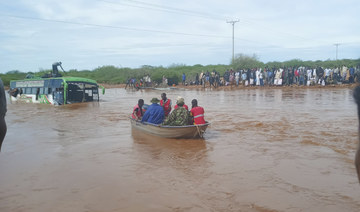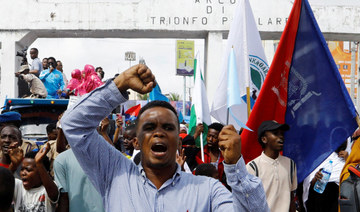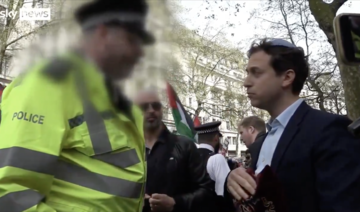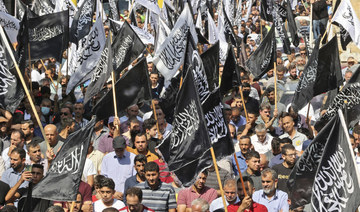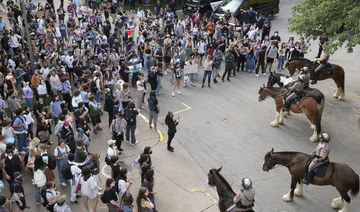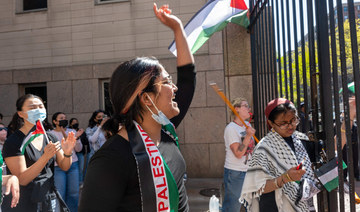CHARLESTON: A revived Hurricane Ian pounded coastal South Carolina on Friday, ripping apart piers and flooding streets after the ferocious storm caused catastrophic damage in Florida, trapping thousands in their homes and leaving at least 27 people dead.
The powerful storm, estimated to be one of the costliest hurricanes ever to hit the US, has terrorized people for much of the week — pummeling western Cuba and raking across Florida before gathering strength in the warm waters of the Atlantic Ocean to curve back and strike South Carolina.
While Ian’s center came ashore near Georgetown, South Carolina, on Friday with much weaker winds than when it crossed Florida’s Gulf Coast earlier in the week, the storm left many areas of Charleston’s downtown peninsula under water. It also washed away parts of four piers along the coast, including two at Myrtle Beach.
Online cameras showed seawater filling neighborhoods in Garden City to calf level. As Ian moved across South Carolina on its way to North Carolina Friday evening, it dropped from a hurricane to a post-tropical cyclone.
Ian left a broad swath of destruction in Florida, flooding areas on both of its coasts, tearing homes from their slabs, demolishing beachfront businesses and leaving more than 2 million people without power.
Even though the storm system has long passed over Florida, new issues were still presenting themselves Friday night. A 14-mile (22-kilometer) stretch of Interstate 75 was closed in both directions in the Port Charlotte area because of the amount of water in the Myakka River.
Many of the deaths were drownings, including that of a 68-year-old woman swept away into the ocean by a wave. A 67-year-old man who was waiting to be rescued died after falling into rising water inside his home, authorities said.
Other storm-related fatalities included a 22-year-old woman who died after an ATV rollover from a road washout and a 71-year-old man who fell off a roof while putting up rain shutters. An 80-year-old woman and a 94-year-old man who relied on oxygen machines also died after the equipment stopped working during power outages.
Another three people died in Cuba earlier in the week as the storm churned northward. The death toll was expected to increase substantially once emergency officials have an opportunity to search many of the hardest-hit areas.
Rescue crews piloted boats and waded through riverine streets in Florida after the storm to save thousands of people trapped amid flooded homes and shattered buildings .
Florida Gov. Ron DeSantis said Friday that crews had gone door-to-door to over 3,000 homes in the hardest-hit areas.
“There’s really been a Herculean effort,” he said during a news conference in Tallahassee.
Hurricane Ian has likely caused “well over $100 billion’’ in damage, including $63 billion in privately insured losses, according to the disaster modeling firm Karen Clark & Company, which regularly issues flash catastrophe estimates. If those numbers are borne out, that would make Ian at least the fourth costliest hurricane in US history.
Florida Division of Emergency Management Director Kevin Guthrie said first responders have focused so far on “hasty” searches, aimed at emergency rescues and initial assessments, which will be followed by two additional waves of searches. Initial responders who come across possible remains are leaving them without confirming, he said Friday, describing as an example the case of a submerged home.
“The water was up over the rooftop, right, but we had a Coast Guard rescue swimmer swim down into it and he could identify that it appeared to be human remains. We do not know exactly how many,” Guthrie said.
Desperate to locate and rescue their loved ones, social media users shared phone numbers, addresses and photos of their family members and friends online for anyone who can check on them.
Orlando residents returned to flooded homes Friday, rolling up their pants to wade through muddy, knee-high water in their streets. Friends of Ramon Rodriguez dropped off ice, bottled water and hot coffee at the entrance to his subdivision, where 10 of the 50 homes were flooded and the road looked like a lake. He had no power or food at his house, and his car was trapped by the water.
“There’s water everywhere,” Rodriguez said. “The situation here is pretty bad.”
The devastating storm surge destroyed many older homes on the barrier island of Sanibel, Florida, and gouged crevices into its sand dunes. Taller condominium buildings were intact but with the bottom floor blown out. Trees and utility poles were strewn everywhere.
Municipal rescuers, private teams and the Coast Guard used boats and helicopters Friday to evacuate residents who stayed for the storm and then were cut off from the mainland when a causeway collapsed. Volunteers who went to the island on personal watercraft helped escort an elderly couple to an area where Coast Guard rescuers took them aboard a helicopter.
Hours after weakening to a tropical storm while crossing the Florida peninsula, Ian regained strength Thursday evening over the Atlantic. Ian made landfall in South Carolina with maximum sustained winds of 85 mph (140 kph). When it hit Florida’s Gulf Coast on Wednesday, it was a powerful Category 4 hurricane with 150 mph (240 kph).
After the heaviest of the rainfall blew through Charleston, Will Shalosky examined a large elm tree in front of his house that had fallen across his downtown street. He noted the damage could have been much worse.
“If this tree has fallen a different way, it would be in our house,” Shalosky said. “It’s pretty scary, pretty jarring.”
Ian’s heavy rains and winds crossed into North Carolina on Friday evening. Gov. Roy Cooper warned residents to be vigilant, given that up to 8 inches (20.3 centimeters) of rain could fall in some areas.
“Hurricane Ian is at our door. Expect drenching rain and sustained heavy winds over most of our state,” Cooper said. “Our message today is simple: Be smart and be safe.”
In Washington, President Joe Biden said he was directing “every possible action be taken to save lives and get help to survivors.”
“It’s going to take months, years to rebuild,” Biden said.
“I just want the people of Florida to know, we see what you’re going through and we’re with you.”
Ian lashes South Carolina as Florida’s death toll climbs
https://arab.news/cxsaa
Ian lashes South Carolina as Florida’s death toll climbs
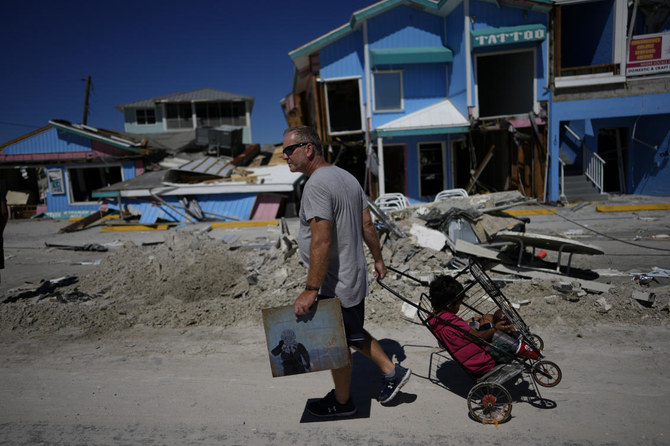
- Ian left a broad swath of destruction in Florida, flooding areas on both of its coasts, tearing homes from their slabs, demolishing beachfront businesses and leaving more than 2 million people without power
Kenya flood death toll since March climbs to 70
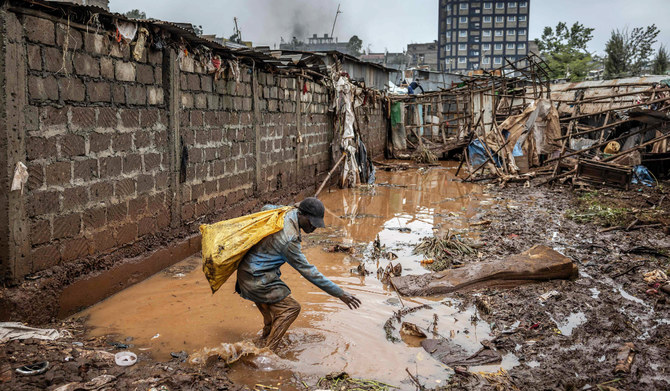
- Tanzania Prime Minister Kassim Majaliwa said on Thursday that more than 200,000 people had been affected by the disaster, with 155 fatalities and 236 people injured
NAIROBI: The number of people killed in floods in Kenya due to heavier than usual rainfall since the start of the monsoon in March has risen to 70, a government spokesperson said on Friday.
In recent weeks, Kenya and other countries in East Africa — a region highly vulnerable to climate change — have been pounded by heavier-than-usual rainfall compounded by the El Nino weather pattern.
El Nino is a naturally occurring climate pattern typically associated with increased heat worldwide, leading to drought in some parts of the world and heavy rains elsewhere.
BACKGROUND
Kenyans have been warned to stay on alert, with the forecast for more heavy rains across the country in the coming days as the monsoon batters East Africa.
“The official tally of fellow Kenyans who regrettably have lost their lives due to the flooding situation now stands at 70 lives,” government spokesperson Isaac Mwaura said on X after torrential rains killed more than a dozen people in the capital, Nairobi, this week.
Mwaura said the government would issue a “comprehensive brief” following a meeting with the national emergency response committee after the extreme weather caused chaos across Nairobi this week, blocking roads and engulfing homes in slum districts. Kenyans have been warned to stay on alert, with the forecast for more heavy rains across the country in the coming days as the monsoon batters East Africa.
At least 155 people have died in neighboring Tanzania due to flooding and landslides.
Tanzania Prime Minister Kassim Majaliwa said on Thursday that more than 200,000 people had been affected by the disaster, with 155 fatalities and 236 people injured.
He said homes, property, crops, and infrastructure such as roads, bridges, railways, and schools had been damaged or destroyed.
In Burundi, one of the poorest countries on the planet, around 96,000 people have been displaced by months of relentless rains, the United Nations and the government said this month.
Meanwhile, the UN humanitarian response agency, OCHA, said in an update this week that in Somalia, the seasonal Gu rains from April to June are intensifying, with flash floods reported since April 19.
It said four people had been reportedly killed and more than 800 people affected or displaced nationwide.
Uganda has also suffered heavy storms that have caused riverbanks to burst, with two fatalities confirmed and several hundred villagers displaced.
Late last year, more than 300 people died in torrential rains and floods in Kenya, Somalia, and Ethiopia, just as the region was trying to recover from its worst drought in four decades that left millions of people hungry.
From October 1997 to January 1998, massive flooding caused more than 6,000 deaths in five countries in the region.
Somalia detains US-trained commandos over theft of rations
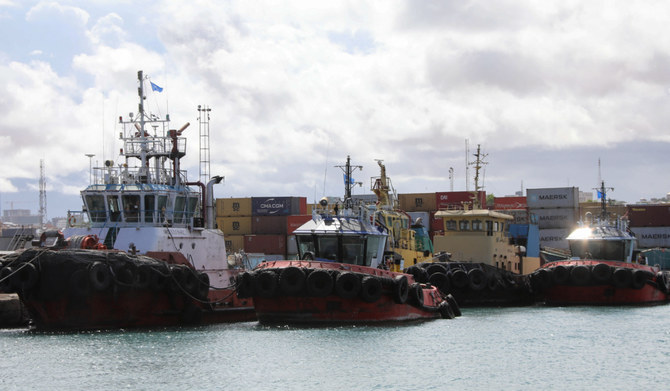
- The US agreed in 2017 to help train and equip the 3,000-strong Danab to act as a quick-reaction strike force against Al-Shabab
MOGADISHU: Somalia’s government said it had suspended and detained several members of an elite, US-trained commando unit for stealing rations donated by the US, adding that it was taking over responsibility for provisioning the force.
The Danab unit has been a key pillar of US-backed efforts to combat the Al-Qaeda-linked militant group Al-Shabab. The US agreed in February to spend more than $100 million to build up to five military bases for Danab.
Somalia’s Defense Ministry said in a statement that it had notified international partners of the theft and would share the outcome of its investigation.
A US official said in a statement to Reuters that Washington takes all corruption accusations seriously.
“We look forward to engaging with the Danab on creating the necessary safeguards and accountability measures to prevent future incidents that could affect future assistance,” the official said, without directly addressing whether any US support had already been suspended.
The US agreed in 2017 to help train and equip the 3,000-strong Danab to act as a quick-reaction strike force against Al-Shabab.
The group has been waging an insurgency against the central government since 2006.
Danab has been heavily involved in a military offensive by the Somali military and allied clan militias since 2022 that initially succeeded in wresting swaths of territory from Al-Shabab in central Somalia.
However, the campaign has lost momentum, with the government-allied forces struggling to hold rural areas and Al-Shabab continuing to stage large-scale attacks, including in the capital Mogadishu.
Washington suspended some defense assistance to Somalia in 2017 after the military could not account for food and fuel.
The US also conducts frequent drone strikes targeting Al-Shabab militants.
Jewish campaign group led by Gideon Falter cancels London march over safety concerns
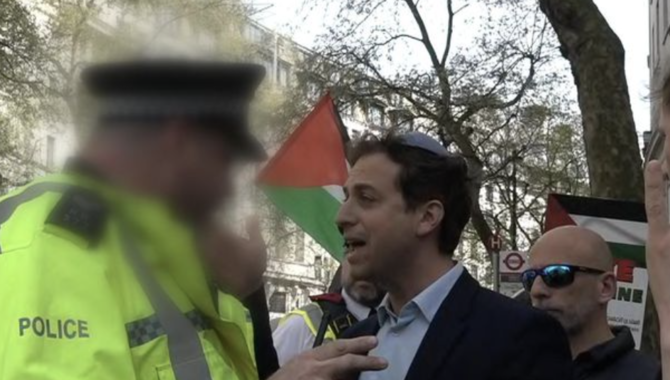
- The Campaign Against Antisemitism says safety concerns forced it to call off its “Walk Together” march after receiving threats from ‘hostile actors’
- Last weekend, a video appeared to show police prevent ‘openly Jewish’ Falter from walking near a pro-Palestine protest but a longer version of the footage painted a different picture
LONDON: The organizers of a march in protest against antisemitism, planned for Saturday in London, “reluctantly” announced on Friday that they were canceling the demonstration.
The Campaign Against Antisemitism said it was forced by safety concerns to call off its “Walk Together” march, which was scheduled to coincide with the latest in a series of pro-Palestine marches in the British capital. The organization said it had expected thousands of people to take part but threats from “hostile actors” posed a safety risk.
“We have received numerous threats and our monitoring has identified hostile actors who seem to have intended to come to any meeting locations that we announced,” the CAA said.
“The risk to the safety of those who wished to walk openly as Jews in London tomorrow as part of this initiative has therefore become too great.
“We are no less angry about these marches than our Jewish community and its allies. We want to walk.”
The group added that it wants the Metropolitan Police not only to “manage marches” but “police” them.
Last weekend, a video that circulated on social media sparked controversy as it showed a confrontation between the CAA’s chief executive, Gideon Falter, and a Metropolitan Police officer who appeared to be preventing him from crossing the road in the vicinity of a pro-Palestine march in London because he was “openly Jewish” and his presence was “antagonizing.”
Falter, who was threatened with arrest if he did not leave the area, criticized the police for their actions during the incident and claimed there were now “no-go zones for Jews” in London amid a rise in antisemitic sentiment arising from Israel’s war on Gaza following the Oct. 7 attacks by Hamas.
Police chiefs apologized twice for the officer’s choice of words. However, a former senior police officer said on Monday that the initial, short version of the video most people saw online “did not fully represent the situation.”
A longer version showed the officer expressing concern about Falter’s actions because he appeared to be deliberately attempting to provoke the pro-Palestinian demonstrators.
Berlin police clear pro-Palestinian camp from parliament lawn
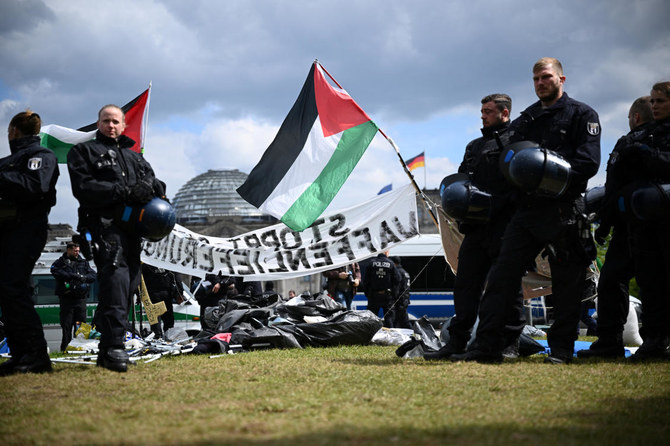
- Police dismantled tents, forcibly removed protesters and blocked the surrounding area to stop others arriving
- "The idea was to draw attention to that and ... to the German complicity and active enabling of the Israeli genocide in Gaza," the camp organizer, Jara Nassar, said
BERLIN: Berlin police on Friday began clearing a pro-Palestinian camp set up in front of the German parliament by activists demanding the government stop arms exports to Israel and end what they say is the criminalization of the Palestinian solidarity movement.
Police dismantled tents, forcibly removed protesters and blocked the surrounding area to stop others arriving.
The action followed clashes between demonstrators and police on US campuses and a blockade at Paris’s Sciences Po university, part of international protests to decry Israel’s military campaign in Gaza and Western support for Israel.
The Berlin camp ‘Besetzung Gegen Besatzung’ — ‘Occupy Against Occupation’ — began on April 8, coinciding with the start of International Court of Justice hearings in Nicaragua’s case against Germany for providing military aid to Israel.
“The idea was to draw attention to that and ... to the German complicity and active enabling of the Israeli genocide in Gaza,” the camp organizer, Jara Nassar, told Reuters.
Israel strongly denies accusations that its offensive in Gaza, which aims to destroy the Palestinian militant group Hamas, constitutes a genocide.
Nassar and a dozen protesters sat on the ground, chanting pro-Palestinian slogans and songs as police with loudspeakers called on them to leave.
“We look at what is happening in the US ... with admiration. There is no reason to believe we should stop now,” said Udi Raz, a PhD student at Berlin’s Free University and a member of the Jewish Voice association.
Raz, who wore a Jewish kippah with the Palestinian flag colors and held his phone in a live social media broadcast of the clearance, said Jewish activists had joined the camp and held a candle-lit Passover dinner there this week.
Police said the prohibition order for the camp, which had been granted authorization at the start of the protest, was due to repeated violations committed by some protesters, including the use of unconstitutional symbols and forbidden slogans.
“Protection of gatherings cannot be guaranteed at this point because public safety and order are significantly at risk,” police spokesperson Anja Dierschkesaid said, adding tents had to be moved daily under local regulations to maintain the lawn.
“For the German government, grass matters more than the lives of more than 40,000 innocent people in Gaza murdered by the Israeli military,” Raz said.
Philippine police kill an Abu Sayyaf militant implicated in 15 beheadings and other atrocities
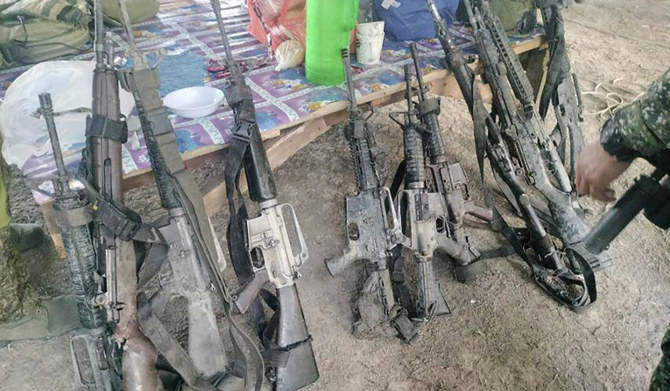
- A confidential police report said that Abdulsaid had been implicated in at least 15 beheadings in Basilan, including of 10 Philippine marines in Al-Barka town in 2007 and two of six kidnapped Vietnamese sailors near Sumisip town in 2016
MANILA: Philippine forces killed an Abu Sayyaf militant, who had been implicated in past beheadings, including of 10 Filipino marines and two kidnapped Vietnamese, in a clash in the south, police officials said Friday.
Philippine police, backed by military intelligence agents, killed Nawapi Abdulsaid in a brief gunbattle Wednesday night in the remote coastal town of Hadji Mohammad Ajul on Basilan island after weeks of surveillance, security officials said.
Abu Sayyaf is a small but violent armed Muslim group, which has been blacklisted by the US and the Philippines as a terrorist organization for ransom kidnappings, beheadings, bombings and other bloody attacks. It has been considerably weakened by battle setbacks, surrenders and infighting, but remains a security threat particularly in the southern Philippines, home to minority Muslims in the predominantly Roman Catholic nation.
Abdulsaid, who used the nom de guerre Khatan, was one of several Abu Sayyaf militants who aligned themselves with the Daesh group.
A confidential police report said that Abdulsaid had been implicated in at least 15 beheadings in Basilan, including of 10 Philippine marines in Al-Barka town in 2007 and two of six kidnapped Vietnamese sailors near Sumisip town in 2016. The Vietnamese were seized from a passing cargo ship.
He was also involved in attacks against government forces in 2022 and a bombing in November that killed two pro-government militiamen and wounded two others in Basilan, the report said.
Abdulsaid was placed under surveillance in February, but police forces couldn’t immediately move to make a arrest because of the “hostile nature” of the area where he was eventually gunned down, according to the report.
On Monday, Philippine troops killed the leader of another Muslim rebel group and 11 of his men blamed for past bombings and extortion in a separate clash in a marshy hinterland in Datu Saudi Ampatuan town in southern Maguindanao del Sur province, the military said.
Seven soldiers were wounded in the clash with the members of the Bangsamoro Islamic Freedom Fighters.
The Abu Sayyaf and the Bangsamoro Islamic Freedom Fighters are among a few small armed groups still struggling to wage a separatist uprising in the southern Philippines.
The largest armed separatist group, the Moro Islamic Liberation Front, signed a 2014 peace pact with the government that eased decades of sporadic fighting.
Moro Islamic Liberation Front rebel commanders became parliamentarians and administrators of a five-province Muslim autonomous region in a transition arrangement after signing the peace deal. They are preparing for a regular election scheduled for next year.



